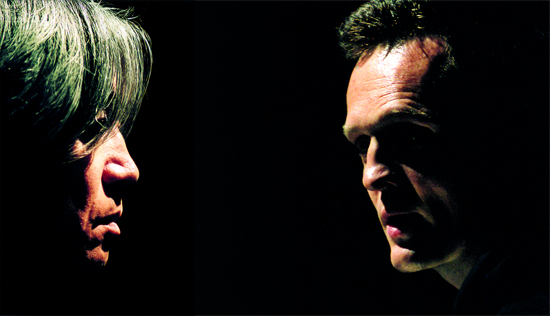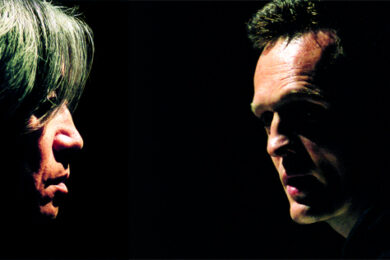Summvs, the fifth collaborative album by Alva Noto, aka Carsten Nicolai, and Ryuichi Sakamoto, is to be premiered Thursday June 12 as part of the Raster Noton 15th anniversary showcase at the Roundhouse in Camden, London. The event kicks off this year’s Short Circuit Festival, which celebrates pioneering figures in electronic music, and will be followed by two days hosted by the highly influential Mute label.
The duo’s latest opus starts with ‘Microon I’, a minimalist,
quasi-monotone sliding around in suspended notes, between majors and minors, with a central drone of thickened, molten notes that bring to mind Zadik Zechariah’s Kurdish zorna melodies and the opaque patterns a piano tuner follows to righten the slippages of time-worn keys. The tracks that follow, like the ‘Microon’ trilogy, which serves as crucial punctuation to the album, lend it a sombre abstraction, with deep pulses, great expanses of filtered white noise and parsimonious, fragmentary piano and digital interference. Other tracks, such as ‘By This River’ and its counterpart ‘By This River – Phantom’, introduce something lighter, albeit as ever slowed down and deconstructed, a pair of erudite studies on the melodious, beat-driven strand of electronica. This last track unravels until it is returned, in its final stretches, to the radical, pared down landscape of the duo’s first outing – ‘Vrioon’. A barely perceptible yet unmistakable beat, single chords played with capacious reverb and impeccable precision – a simplicity of form that slows your very heartbeat as you listen, drawing you in as if into deepest slumber. This economy of means – though by now a familiar trademark of what happens when these two inimitable musicians join hands – remains astonishing and undiluted in its potency.
I’ve been listening to your first album, Vrioon, since it came out, and it was only when I was preparing for this interview that I realised it’s almost 10 years old.
Alva Noto: We only just realised that too! The album was released nine years ago, but we started working on it more than a year before that, so it has in effect been 10 years.
How did you start working together?
AN: I of course knew Ryuichi’s work but I had never met him. And then he came to one of the first concerts I ever did in Japan. He is a naturally a very curious person, always looking for new things.
Ryuichi Sakamoto: When I first saw Carsten’s performance, I
immediately thought ‘Something really great could come from
collaborating with this guy’. At that time I wasn’t really aware of that kind of electronic music yet, but I could tell he had talent.
How do you approach collaboration?
AN: In my solo and visual work I am very strict and straight. And I find collaborations often grow out of a need for something different. When we started working together it was a big challenge for me to break that image I had before. And I like that – countering the cliché, defying people’s expectations. I think that is one of the driving forces of my work – breaking the borders.
As a visual artist, you work alone, whereas in music there is this great ability to share things and to work together. People always have been working together. If you do a great album, you can be 100 percent sure you will be invited to collaborate with someone else. At the moment I am working with Michael Nyman and that collaboration came about in exactly that way – he wanted to work with me, and I couldn’t resist going for it. It is wonderful to break the loneliness.
RS: I like collaborating with people who have something I don’t have – a skill, an idea… I’m always looking for something surprising – like everyone else, I need inspiration and triggers. Listening to new things, looking for new sounds has become part of my nature. And I think that’s why you collaborate – to stay open. Unexpected things happen and you must be very flexible. You can of course hide by yourself, digging into your inner depths – we all need that kind of space sometimes. But working with other people’s ideas and artistic presentation can be so enriching. A really memorable instance of collaboration happened when I was working on Beauty in 1989. I had asked Brian Wilson to sing on the album so I went to Los Angeles and we recorded with him. I had been informed that he had had a difficult time, some kind of mental illness, and I could sense that, even though he wasn’t that surprising in the studio. But then the following day, I flew from LA back to New York to continue recording and he showed up without telling me, with his whole family in tow. The schedule was already tightly planned, but I was so grateful he’d come, so we made some time to work with him. It was a beautiful moment – one I won’t forget for the rest of my life.
Do you collect sounds?
RS: I’ve been doing field recording for many years – I don’t use the recordings, I just keep collecting them. If I was a painter I would probably draw – recordings are something like that for me. Even if I’m writing a beautiful romantic melody, it will be always triggered by a particular sound. When I get good sound, I can write good music.
AN: I really love animal sounds. As a kid I was really into birds. I would go into the forest to make notes about what sounds I could hear. Recently I was invited to a project with a Japanese photographer. He had images from the zoo. So I started downloading things from the Humboldt university here about monkeys. The sounds are really crazy. I loved that. I’ve been making monkey loops. I’m also really into languages. Language has such great potential and complexity. It is both sound and system. There is a very big social component. You can deliver emotion, information – it’s fascinating.
Are there particular listening instants or spaces have made a big impression on you?
AN: When you work in music or sound, people always ask you what music you listen to and I actually really enjoy listening to nothing, to the silence. I love coming back to my apartment when it’s quiet. There is so much music around us when you go anywhere. That said, listening in an anachoic chamber or a dead room, where there is no sound at all – that’s a very scary experience. Not one I would easily put myself in, but a great experience all the same. I also like very large rooms with a lot of reverb, like expansive, empty industrial spaces. Maybe the attraction stems from the fact that I grew up in a city surrounded by huge old factories.
RS: When I was in the Arctic a few years ago, I chartered a boat, and recorded with the microphone under the sea. At one point I heard a big BAAAAAAM BOOOOM – a kind of explosion. I thought it was a huge whale near us and that probably he or she wanted to play with me. I was quite afraid. But then nothing happened. Maybe the sound was just the ice cracking. It was very scary and very exciting.
Alva Noto and Ryuichi Sakamoto play the Roundhouse Short Circuit Festival tonight as part of the celebration of 15 years of the Raster Roton label. For tickets and information go here



